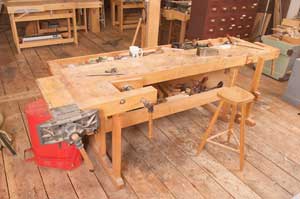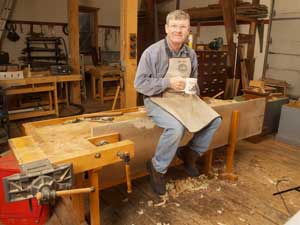Serious woodworking started at least in Egyptian times: it is amongst the oldest of crafts. By the 18th century, the workbench was pretty well thought-out, but came to absolute perfection after 1850. The second half of the 20th Century has seen a gradual decline of the workbench. I place the blame for this on well-meaning engineers who may be bright young graduates of prestigious schools, but sadly deficient in any real understanding of woodworking. These meddlers have tweaked workbench design in the name of “streamlining” manufacture, adding “usability” to the product or simply satisfying the latest marketing research.

What is commonly called a European workbench represents the zenith of bench design. Stout trestle legs support the heavy top, which has a tail vise with a series of progressively spaced rectangular holes that carry the movable dog. An opposing row of equally spaced holes are housed in the face of the bench to carry the fixed dog. The reason for the progressively spaced holes in the tail vise jaw is that, if your piece is just a bit bigger than the distance from the lead dog hole to a fixed hole, you simply pick an alternate and only have to turn the vise half or a quarter of the distance.
Cheapness of manufacture has seen a good deal of inbreeding of the dogs so that, nowadays, we have chihuahuas where mastiffs once stood. Worst of all are round dogs, which only have “cheapness of manufacture” as a strong point. If you dog (yes, it is a verb as well) a strip of wood left of the center of a round dog, which is necessary for much work performed with plow and rabbet planes, the workpiece will be spit on the floor when you tighten the tail vise. Our forefathers made the dog holes square for very good reasons. Other cheaping has been the use of thinner wood or even plywood behind the front apron.
Most Euro benches still have a tail vise that works adequately, but the vise at the left end of the bench is another matter. Early benches generally had a leg vise, which is a large plank that pivots off of the left leg of the bench near the floor. The pivot point can be changed to accommodate thicker material. The plank is tightened by a 2″ to 2-1/2″ or better wood screw. The system works very well. The shoulder vise evolved in the 19th century. It works much better than the leg vise because no spindles interfere with the jaws. An arrangement of heavy wood timbers forms an open-sided box at the left face of the bench. Looking down from above, it looks like a man’s shoulder. The front beam of the vise was tapped for a 2” to 2-1/2″ threaded wood screw but today has a metal nut for an acme-threaded steel spindle.

The threaded wood or steel spindle has a floating plate that forms the jaw. The other jaw is the face of the bench itself. This allows it to grip trapezoidal shaped objects easily, and they can extend to the floor because there are no spindles between the jaws. With the aid of a jack, work can be supported at any height to the right of the shoulder vise. The right end of an interior door can be rested on the jack and the left end clamped in the shoulder vise. You can now plane the entire edge of the drawer, or work on it with power tools if you prefer.
– Ernie Conover





